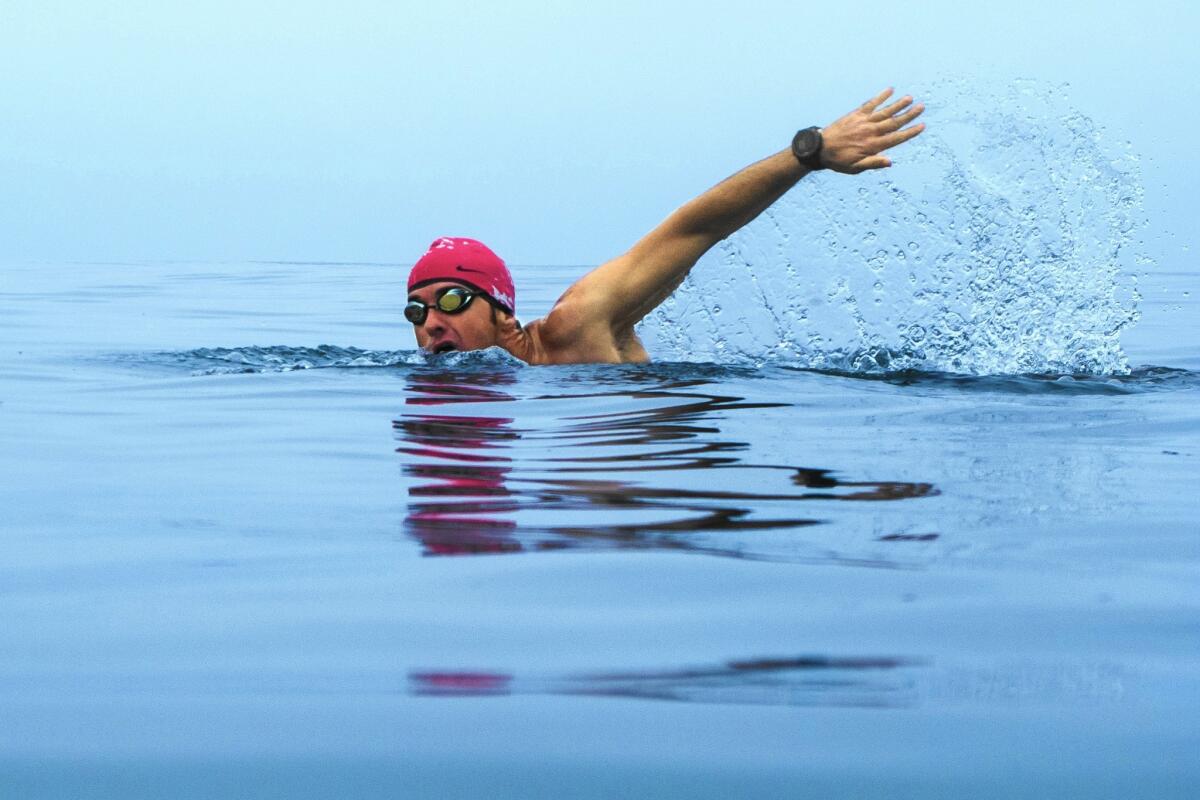How one man conquered his paralyzing fear of swimming in open water (and how you can too)

- Share via
On an unusually chilly Friday evening, Culver City’s public pool bustled with activity. Dozens of swimmers kicked and splashed as bundled-up coaches called instructions from the deck. At one end of the pool, Joe McCauley swam a lap of freestyle. His arms circled slowly, deliberately. His torso popped out of the water like a jack-in-the-box with every breath.
“I’m still last in the slow lane,” McCauley, 38, said after his lesson late last year. But that was progress: Only a couple of weeks earlier, “I couldn’t even make it to the end of the pool.”
For most of the last three decades, McCauley has been gripped by a paralyzing fear of swimming in open or deep water. It’s not an uncommon condition.
About 12.5% of American adults will suffer from some kind of phobia in their lifetimes, according to the National Institute of Mental Health. The organization doesn’t have numbers on aquaphobia, or fear of the water. But Kenneth Rippetoe, a swim coach who teaches at the Culver City pool, estimates that 20% of the adults who come to him for private lessons grapple with some degree of aquaphobia.
“Typically, something happened in their childhood,” he said, “like a near-drowning accident.”
For McCauley, it started on Lake Powell in Arizona one spring morning 26 years ago. During a training dive with his scuba class, a seal on his oxygen tank came loose 25 feet under the surface. McCauley had enough air to breathe, but a constellation of bubbles fanned out behind his head as air escaped his equipment. Seeing this, his dive partner — an older man — swam around behind McCauley and, in a panicked attempt to fix the problem, accidentally cut off McCauley’s air supply.
“I didn’t know what was happening,” McCauley recalled. “I just remember trying to take a couple of breaths and not being able to.” He ripped off his scuba gear and started swimming up as fast as he could. When he finally broke through the surface, his lungs felt like they would burst. The whole incident probably took less than three minutes.
Dr. Emanuel Maidenberg, a clinical professor of psychiatry who specializes in anxiety disorders at UCLA’s David Geffen School of Medicine, said that phobias often start with one traumatic experience and, untreated, tend to blossom. Over time, sufferers avoid more and more situations to stave off their anxiety.
For McCauley, those few minutes at Lake Powell led to an extreme aversion to swimming in lakes, oceans and pools. As a college student at the U.S. Naval Academy in Annapolis, Md., he cut mandatory swim classes and had a friend sign his name on attendance sheets.
He got away with it, though the truancy could have gotten him expelled, and he went on to become a helicopter pilot with multiple deployments to Iraq and Afghanistan.
Last summer, the catalyst he needed to finally tackle his fear came when his 12-year-old daughter, Aine, signed up for a two-mile ocean swim between Hermosa and Manhattan beaches. In a show of solidarity, the divorced father of two signed himself up as well.
“It was just like going to war,” he said. “I thought, this is going to suck, but I had to do it.”
To get through it, McCauley relied on what he calls “pilot survival side stroke,” keeping his head above water the whole time. “It was terrible,” he said. He tied for last place, clocking in at an hour and 40 minutes. Nonetheless, he felt pleased. It might not have been pretty, but he’d done it. Buoyed, he signed up for classes at the Culver City pool that week.
Exposure therapy, facing the very thing causing fear, is in fact the best treatment for phobias, according to Maidenberg.
“They become reinforced, habits of avoidance, by not experiencing the anxiety,” he said. “Anxiety goes down if we simply learn to tolerate it.”
Of course, that’s easier said than done. But now McCauley swims five days a week. He recently competed in a couple of organized ocean swims. In August he plans to give the Hermosa-to-Manhattan Beach swim another shot. He’s still slow (his daughter beats him, he says), but his stroke has improved and his fear has subsided.
In typical teenage fashion, his daughter isn’t overly impressed with his progress, he said.
“He started off a beginner, doggy paddling,” Aine said. “But now he can swim and he’s pretty fast. I guess he has a new perspective on water.”
“It’s not like I look forward to it,” McCauley said. “I wouldn’t say it’s pleasurable. But there’s … less focus on trying not to drown and more on technique. I’m starting to scratch the surface.”
::
Overcome your swimming fear in these places:
Kenneth Rippetoe, a swim coach at One With the Water, says he takes things slowly when people are learning to swim but are afraid.
“It becomes almost a therapy session,” he says. “You have to acknowledge that the fears exist. We might start by putting your face in the water, realizing you can stand on the bottom. A lot of it is holding their hands — literally — and doing things together. We might blow bubbles, then put their chins in, then lower their mouths and noses in, and then full submersion, sitting on the bottom. You can get them on their backs, hold their heads and let them float. It’s incredible, to go from the grip of death to have them doing it alone, a lot of the time, in an hour.”
If you can relate to Joe McCauley’s fear of the water, here are some places with swim lessons for adult beginners:
• One With the Water. Lessons in Santa Monica, Culver City, Gardena. Also house calls. onewiththewater.org
• YMCA of Metropolitan Los Angeles, multiple locations, ymcala.org
• Swimming Los Angeles. Offers one day, three-hour adult beginner clinics at Palisades Charter High School, 15777 Bowdoin St., Pacific Palisades. swimmingla.com
McCauley plans to compete Aug. 2 in the Dwight Crum Pier-to-Pier Swim. Last year more than 1,100 swimmers completed the two-mile course. Swimmers enter the water on the south side of the 10th Street Lifeguard Tower, south of the Hermosa Beach Pier. They swim around the pier, parallel to the shore, then around the Manhattan Beach Pier and finish on the beach. surffestival.org






